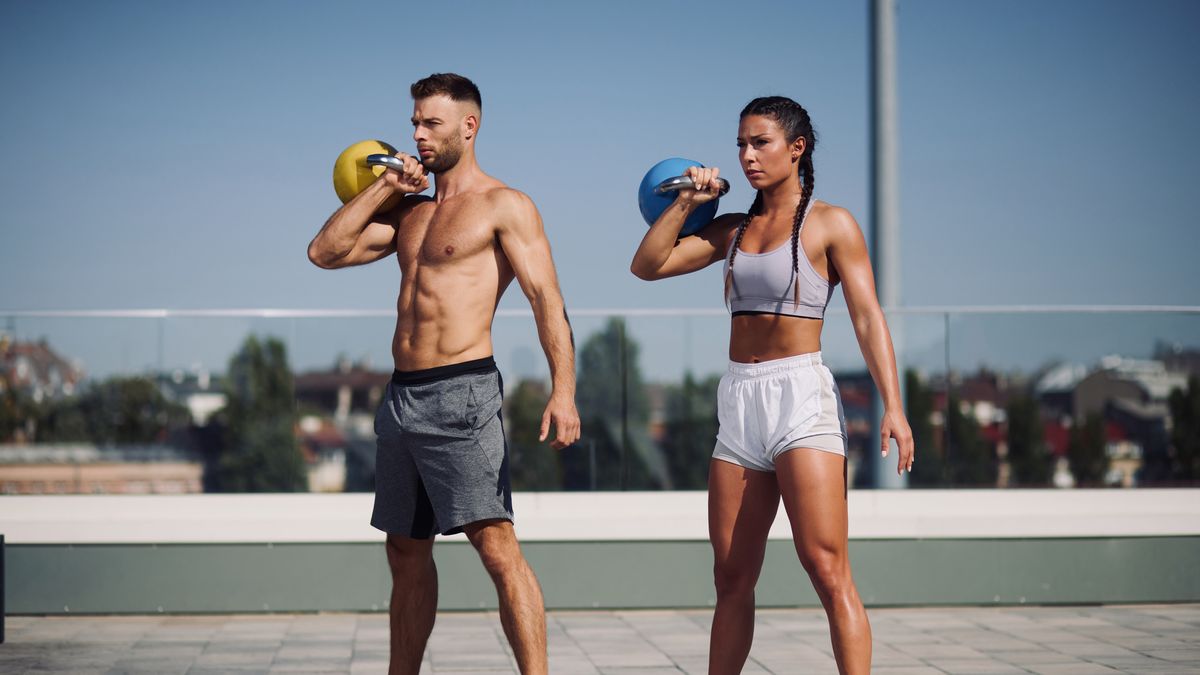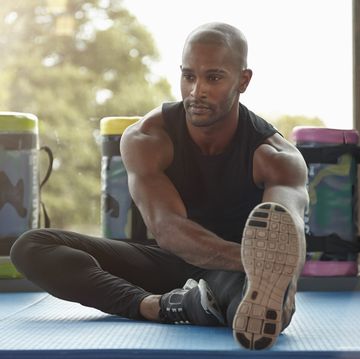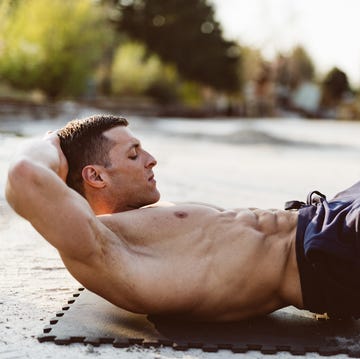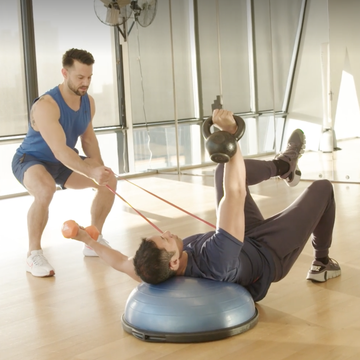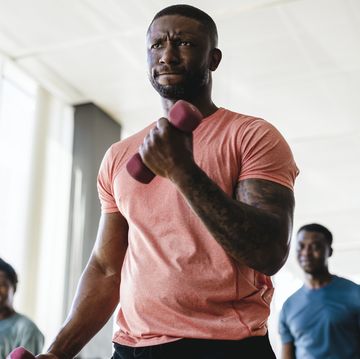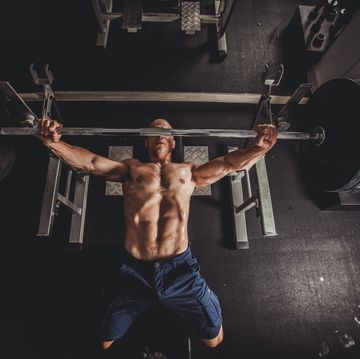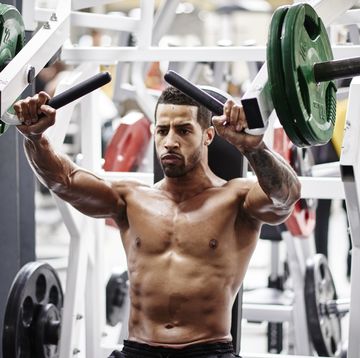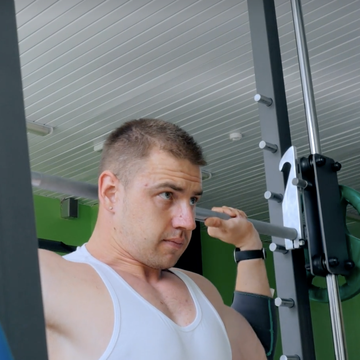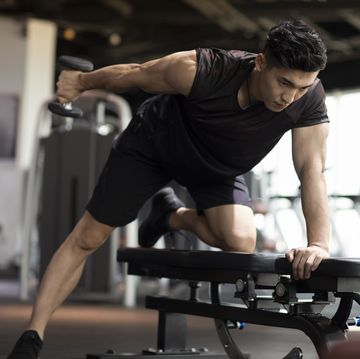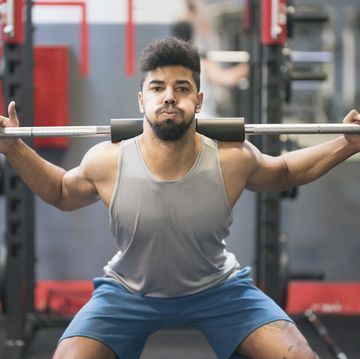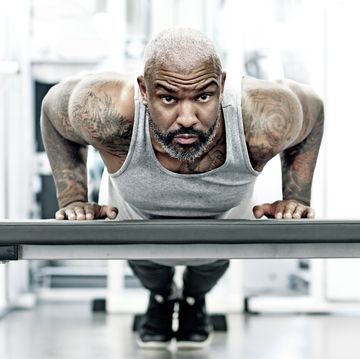KETTLEBELL FLOWS ARE a sight to see. These freewheeling workouts can appear as if someone pieced together dance choreography and lifting (which is probably part of the reason the paired-up, stone-faced flow highlight has become an influencer favorite). But not everything flashy can always back up the hype—and if you're looking to achieve specific goals with your training, kettlebell flows might not be your best bet.
While the energy around a flow is entrancing, the format does very little for building muscle. The quick nature of the routines means you'll spend little time focusing on any one specific muscle group. "Kettlebell flows look amazing, they feel fun, and they are really, really unique to do. They're also a waste of time if you're trying to build muscle and strength," says Men’s Health fitness director Ebenezer Samuel, C.S.C.S., joined by Mathew Forzaglia, N.F.P.T., C.P.T., founder of Forzag Fitness.
That being said, any training program is goal-dependent. If you're using the flow to have fun and get your heart rate up, by all means, grab your kettlebell and get moving. But if you're looking for a purpose-driven, muscle-building session, skip the freewheeling flow and opt for more structured, traditional kettlebell workouts.
Why The Flow Is Just for Show
It's Hard to Build Mind-Muscle Connection
When you're shifting from a shoulder press immediately into a reverse lunge, your brain doesn't know exactly where you're going to load next. It may take a few reps for your brain to light up all of the fibers of the muscle you're loading. In a kettlebell flow, there's not enough time for your brain to understand what's being targeted.
"It winds up just not being an efficient way to build muscle," Samuel says.
There's No Consistency in Loading
Some muscles are bigger and stronger than others. Your max squat probably doesn't equate to your max overhead press. But with kettlebell flows, you're using the same sized kettlebell for every movement of your flow. Here comes the discrepancy in challenge. If you do your flow with a 30-pound kettlebell, the overhead press portion might feel difficult, but the squat portion won't be.
The inconsistency here means you can't maximize your movements. You might be able to make the overhead press difficult, but then you're not challenging your squat. Flows do not allow you to prioritize muscle building.
There's Little Time Under Tension
Weight aside, the next thing that builds muscle is time under tension. Even if you're lifting a light weight, if it's loaded long enough, your muscles will still be taxed. But, we're not getting this aspect of strength training in kettlebell flows, either.
Switching the active muscle group every single rep in a flow means you're not engaging your muscles enough. The one second your muscles are contracted in that single rep is not going to build the gains you want to see.
"We're not really loading the body in a way where we're taking it over the top to really build the full potential of strength," says Forzaglia.
3 Kettlebell Flow Alternatives to Build Strength
Opt for a Kettlebell Circuit
If you're working with limited equipment and only have a single kettlebell, opt for a circuit of structured exercises rather than a flow. That way, even though the weight is staying the same, you're able to add in the time under tension, which creates that mind-muscle connection aspect to build muscle. So, instead of doing one rep of something into one rep of something else into one rep of something else, do 10 reps of each movement before moving onto the next. Try this instead for your next kettlebell session:
- 10 lateral lunges
- 10 single-arm swings
- 10 overhead presses per side
- 10 kettlebell rows per side
Rest for 60 to 90 seconds. Complete 3 to 5 rounds.
Stick with the Standard Reps and Sets
Simplify your workout even more by sticking with the basics. There's no reason to be switching from move to move between sets. Finishing out a few sets of one exercise to burn it out before moving on to the next one. This works especially well if you have multiple kettlebells and can work with different weights for each exercise. Try it this way:
- 3 sets of 8 to 10 kettlebell rows per side
- 3 sets of 8 to 10 overheard presses per side
- 3 sets of goblet squats
- 3 sets of 10 swings
Use the Flow as a Finisher—Not the Whole Workout
We know flows look cool and can be fun. Working out should be fun. So if you absolutely want to use a flow to have a good time, then use them as your finisher. Make the flow part of your workout, instead of the center. Get some good quality reps for muscle building in first, and then utilize the flow to finish out. Here's a sample workout—with a flow to cap it off.
- 3 sets of 8 to 10 machine rows
- 3 sets of 10 to 12 dumbbell bench presses
- 3 sets of 10 reverse lunges (per leg)
- 5 minutes of kettlebell flow
"That way, you're getting that fun factor in, you're getting the cardiovascular effect out of it, you get a little bit of momentum transfer work, and you get to have your fun," says Samuel. "But you're still going to actually build the muscle you want."
Learn which exercises you're better off avoiding by checking out our entire Overrated series here.
Cori Ritchey, NASM-CPT is an Associate Health & Fitness Editor at Men's Health and a certified personal trainer and group fitness instructor. You can find more of her work in HealthCentral, Livestrong, Self, and others.
